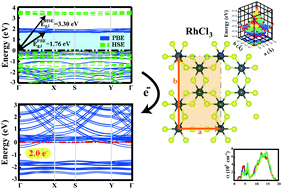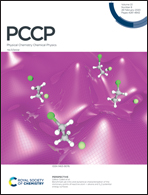Tuning the electronic structure of RhX3 (X = Cl, Br, I) nonmagnetic monolayers: effects of charge-injection and external strain†
Abstract
Atomistic exploration and electronic modification of 2D materials have been a central focus of research since the breakthrough of graphene. In the present study, we introduce and reveal the structure, stability and electronic features of novel RhX3 (X: Cl, Br, I) monolayer systems within the framework of density functional theory. Phonon dispersion spectra and equilibrium molecular dynamics calculations confirm the stability of the phases studied at room and elevated temperatures. The structures are slightly modified because of thermal excitations and maintain their stabilities up to 1000 K. We show that the electronic and magnetic nature of pristine monolayers can be tuned by external effects, i.e. both mechanically and electrically. RhCl3, RhBr3 and RhI3 monolayers are nonmagnetic and indirect-gap semiconductors intrinsically, but display indirect-to-direct band gap transitions at particular strain values. The systems gain a net magnetic moment and are transformed into metals by negative charging. The optical properties, such as the absorption coefficient, optical conductivity, energy loss spectrum, refractive index and extinction coefficient, are also presented. This interesting class of nanomaterials are promising candidates for several applications in nanotechnology and optoelectronics with good thermal stability, mechanical flexibility, and tunable electronic properties.



 Please wait while we load your content...
Please wait while we load your content...